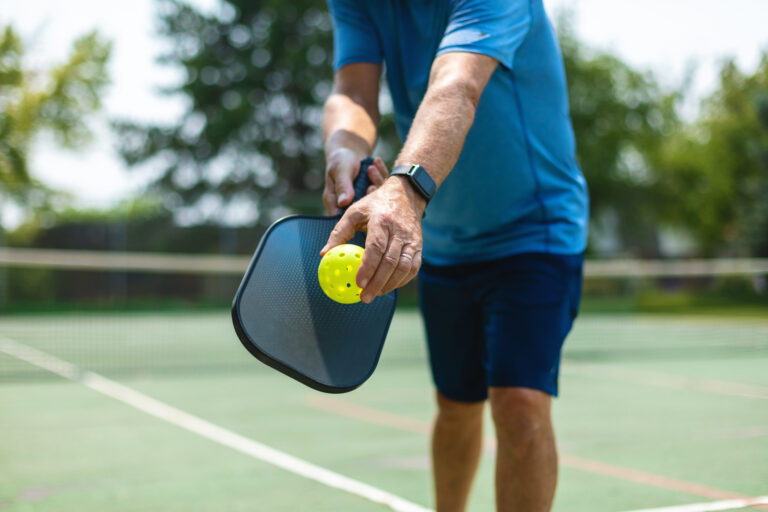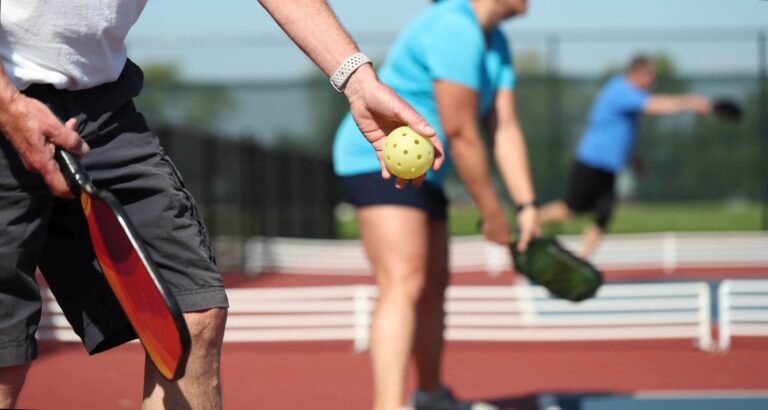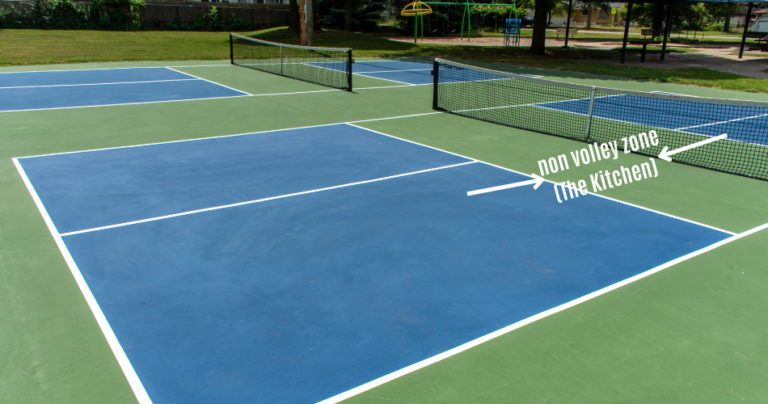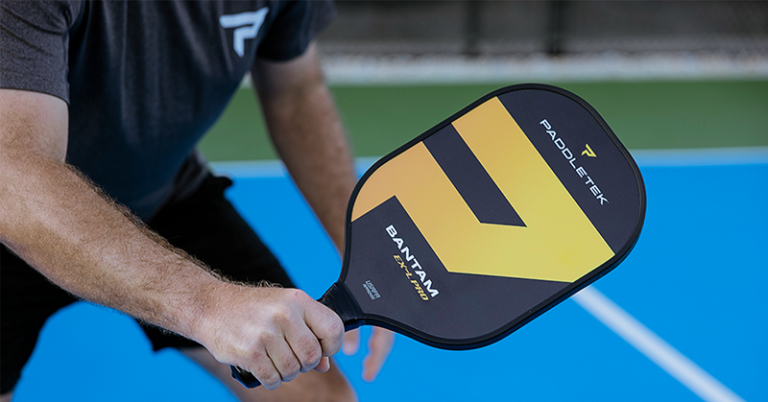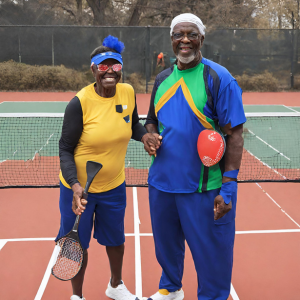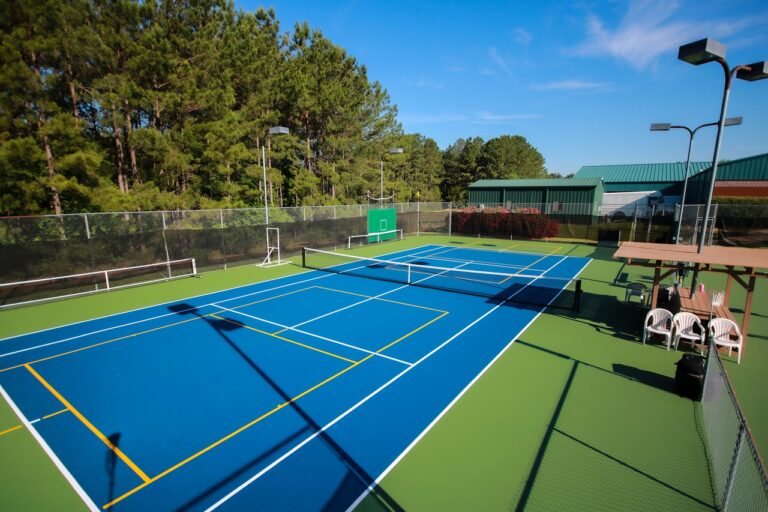How to Play Pickleball on a Tennis Court: The Ultimate Guide
How to Play Pickleball on a Tennis Court: A Complete Guide for Casual Players
Playing pickleball on a tennis court is a great way to enjoy the game when dedicated pickleball courts are not available. With a few simple adjustments to the net height and court dimensions, you can easily transform a tennis court into a suitable pickleball playing area. This comprehensive guide covers all the essential aspects of setting up and adapting your game to a tennis court surface, ensuring you have a fun and safe pickleball experience. Whether you’re a seasoned pickleball player or a tennis enthusiast looking to try something new, this article provides the knowledge and tips you need to successfully play pickleball on a tennis court.
Key Takeaways
- Pickleball can be easily played on a tennis court with minimal adjustments to the net height and court dimensions.
- A tennis court can accommodate up to four pickleball courts, making it a cost-effective and accessible option for casual players.
- When setting up a pickleball court on a tennis court, consider using temporary line markings, such as chalk or painter’s tape, to define the court boundaries.
- Adapt your playing style to the tennis court surface, whether it’s clay, grass, or hard court, by adjusting your swing, footwork, and shot selection.
- Take advantage of the larger playing area by utilizing extra space, adapting to higher bounces, and exploiting tennis court features like back walls or fences.
- Prioritize safety by ensuring proper court setup, being aware of your surroundings, wearing appropriate footwear, and following basic pickleball rules and etiquette.
- Encourage tennis players to try pickleball by setting up courts on tennis courts and organizing friendly games or tournaments.
By following this guide on how to play pickleball on a tennis court, you’ll be well-equipped to enjoy this exciting sport with friends and family, even if you don’t have access to a dedicated pickleball court. So grab your paddles, head to your local tennis court, and start playing!
What is Pickleball?
Before we dive into the nitty-gritty of how to play pickleball on a tennis court, let’s take a moment to understand what pickleball is all about. Invented in 1965 by three dads looking to entertain their bored kids, pickleball has evolved into a worldwide phenomenon. The game is played on a smaller court than tennis, with a lower net, and uses solid paddles and a perforated plastic ball.
The basic rules of pickleball are simple:
- Serve underhand diagonally across the court
- The ball must bounce once on each side before volleys are allowed
- Players cannot volley from the non-volley zone (or “kitchen”) near the net
- Points are scored only by the serving team
- The first team to reach 11 points (with a lead of 2) wins the game
While pickleball shares some similarities with tennis, there are a few key differences:
| Feature | Pickleball | Tennis |
|---|---|---|
| Court Size | 20′ x 44′ | 78′ x 36′ (doubles) |
| Net Height | 34″ at the center | 36″ at the center |
| Scoring | 11 points, win by 2 | Games, sets, and matches |
| Unique Rules | Double bounce rule, non-volley zone | – |
Why Play Pickleball on a Tennis Court?
Now that you have a basic understanding of pickleball, you might be wondering why you should consider playing pickleball on a tennis court. Here are a few compelling reasons:
- Availability: Tennis courts are far more common than dedicated pickleball courts. You can find them in public parks, community centers, and even some residential areas. This means you have more opportunities to play pickleball on a tennis court without having to travel far or wait for an available court.
- Cost-effective: Building a dedicated pickleball court can be expensive, especially if you’re just starting out or playing casually with friends. By playing pickleball on a tennis court, you can save money on construction and maintenance costs.
- Introducing pickleball to tennis players: Many tennis players are curious about pickleball but may not have access to a dedicated court. By setting up a pickleball court on a tennis court, you can introduce the sport to a new audience and potentially grow the pickleball community in your area.
Setting Up Your Pickleball Court on a Tennis Court
Now that you’re convinced that playing pickleball on a tennis court is a great idea, let’s get into the specifics of setting up your court.
Tennis Court vs. Pickleball Court Dimensions
The first thing to consider when learning how to play pickleball on a tennis court is the size difference between a tennis court and a pickleball court. A standard tennis court measures 78 feet long by 36 feet wide (for doubles), while a pickleball court is much smaller at 44 feet long by 20 feet wide. Find Out How Many Pickleball Courts Fit on a Tennis Court! Click Here to Learn More!
This size difference means that you can fit up to four pickleball courts on a single tennis court, depending on your desired play style and the number of players. Here’s a quick breakdown:
- One pickleball court: Use the full tennis court, with the pickleball court centered within the tennis court lines.
- Two pickleball courts: Set up the courts side-by-side, with the long side of the pickleball court running parallel to the tennis net.
- Four pickleball courts: Arrange the courts in a square formation, with two courts on each side of the tennis net.
Keep in mind that setting up multiple courts will require more equipment and may take longer to set up and take down.
Net Height Adjustment
Another important consideration when learning how to play pickleball on a tennis court is the net height. A pickleball net is slightly lower than a tennis net, measuring 34 inches at the center compared to 36 inches for tennis.
If you’re using a portable pickleball net, this won’t be an issue. However, if you’re using the existing tennis net, you’ll need to make some adjustments. Here are a few options:
- Adjustable net: Some tennis nets have an adjustable center strap that allows you to lower the net height. This is the easiest and most convenient option if available.
- Tie the center strap: If your tennis net doesn’t have an adjustable center strap, you can try tying the existing strap to lower the net slightly. This may not achieve the exact 34-inch height, but it will be close enough for casual play.
- Use a portable net: If you have a portable pickleball net, you can set it up directly in front of the tennis net. This will ensure the correct height and eliminate the need for any adjustments.
Remember, some casual players might be okay with the slightly higher tennis net, especially if you’re just playing pickleball on a tennis court for fun and not following official tournament rules.
Equipment Needed
To set up your pickleball court and start playing pickleball on a tennis court, you’ll need the following equipment:
- Pickleball net (if not using the tennis net)
- Pickleball paddles (one per player)
- Pickleballs (at least a few, in case some get lost or damaged)
- Court markers (to define the pickleball court boundaries)
You can find pickleball equipment at most sporting goods stores or online retailers. If you’re just starting out, consider purchasing a beginner’s set that includes paddles, balls, and a portable net.
Marking the Pickleball Court Lines (Optional)
While it’s not strictly necessary to mark the pickleball court lines when playing pickleball on a tennis court, it can be helpful in certain situations. For example, if the tennis court lines are faded or difficult to see, marking the pickleball court boundaries can make it easier to play and avoid disputes over line calls.
When to Mark Lines
Here are a few scenarios where marking the pickleball court lines might be beneficial when learning how to play pickleball on a tennis court:
- The tennis court lines are unclear or faded
- You’re setting up multiple pickleball courts on a large tennis court
- You’re hosting a pickleball tournament or league and want to ensure consistent court dimensions
Getting Permission
Before you start marking any lines on a tennis court, it’s essential to get permission from the court owner or manager. Some facilities may have specific rules or restrictions regarding court modifications, and you don’t want to risk damaging the court or getting in trouble.
If you’re playing pickleball on a public tennis court, check with your local parks and recreation department to see if they allow temporary court markings. If you’re using a private court, talk to the owner or manager to get their approval.
Temporary Line Marking Options
When marking pickleball court lines on a tennis court, it’s best to use temporary, non-permanent options that won’t damage the tennis court surface. Here are a few popular choices:
- Chalk: Sidewalk chalk is an easy and inexpensive way to mark court lines. It’s visible, washes away with rain or water, and doesn’t leave any residue. Just be sure to use a color that contrasts with the court surface for better visibility.
- Painter’s tape: Blue painter’s tape is another good option for marking court lines. It’s easy to apply, stays in place during play, and peels off without leaving adhesive residue. Choose a tape width of 1-2 inches for clear, visible lines.
- Court marking kits: Some companies offer specialized pickleball court marking kits that include pre-measured lines, corner markers, and even temporary nets. These kits are designed for easy setup and removal, making them a convenient choice for frequent players.
When marking the court lines, use the existing tennis court lines as a guide whenever possible. This will save you time and ensure that your pickleball court is properly aligned. Here’s a quick overview of the main lines you’ll need to mark:
- Baseline: The back line of the pickleball court, which should be 22 feet from the net on each side.
- Sidelines: The side boundaries of the court, which should be 10 feet from the center line on each side.
- Non-volley zone (kitchen): The 7-foot area on each side of the net where players cannot volley the ball. Mark this line parallel to the net and 7 feet away.
- Center line: The line that divides the service areas, running perpendicular to the net. You can use the existing tennis court center line as a guide.
Remember to measure carefully and double-check your lines before starting play to ensure a fair and accurate game.
Adapting to the Tennis Court Surface
Tennis courts come in a variety of surfaces, each with its own characteristics and playing properties. The three most common types are:
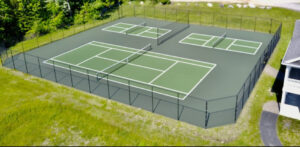
- Clay courts: Made of crushed shale, stone, or brick, clay courts are known for their slow ball speed and high bounce. The soft surface allows players to slide, making it easier to change direction and reach tough shots.
- Grass courts: Less common than clay or hard courts, grass courts are the fastest surface due to the low bounce and quick ball speed. The uneven surface and unpredictable bounces can be challenging for players used to more consistent surfaces.
- Hard courts: Made of asphalt or concrete with an acrylic coating, hard courts offer a balanced playing experience with moderate ball speed and bounce. They are the most common type of tennis court and are generally easier to maintain than clay or grass.
When learning how to play pickleball on a tennis court, it’s essential to consider how the surface will affect your game. Here are a few tips for adapting to different court surfaces:
- Clay courts: Expect a slower, more controlled game with longer rallies. The high bounce may require you to adjust your swing and aim higher over the net. Be prepared for more physical exertion, as the soft surface can be tiring to move on.
- Grass courts: Anticipate a faster-paced game with lower bounces and more skidding shots. Stay light on your feet and be ready to react quickly to unpredictable bounces. Serve and volley strategies can be particularly effective on grass.
- Hard courts: Expect a balanced game with moderate ball speed and bounce. Hard courts offer the most consistent playing experience, making them ideal for players of all skill levels. Focus on your footwork and court positioning to take advantage of the even surface.
Regardless of the court surface, it’s important to wear appropriate footwear to prevent slips, falls, and injuries. Look for shoes with good lateral support, cushioning, and non-marking soles to protect the court surface.
Additional Considerations for Playing Pickleball on a Tennis Court
While playing pickleball on a tennis court is a great way to enjoy the sport, there are a few additional factors to keep in mind to ensure a smooth and enjoyable experience. Compare Tennis and Pickleball Courts! Click Here to See the Differences!
Playing Area
One of the biggest differences between a dedicated pickleball court and a tennis court is the size of the playing area. A tennis court is significantly larger than a pickleball court, which means you’ll have more space to cover and longer distances to run.
To adapt to the larger playing area when playing pickleball on a tennis court, consider the following strategies:
- Court positioning: Stay closer to the center of the court to minimize the distance you need to cover. This will help you react quickly to shots hit to either side of the court.
- Communication: If you’re playing doubles, communicate clearly with your partner about who will cover which areas of the court. This will help prevent confusion and ensure that all shots are covered.
- Shot selection: With more space to work with, you may need to adjust your shot selection. Aim for deeper, more angled shots to push your opponents back and create openings for yourself at the net.
Stray Balls
Another consideration when playing pickleball on a tennis court is the potential for stray balls to interfere with play. Since the playing area is larger and the court boundaries are not as clearly defined, it’s easier for balls to bounce or roll into adjacent courts or out of play.
To minimize disruptions from stray balls, try the following:
- Set up a temporary barrier: If you’re playing on a court with multiple pickleball games happening simultaneously, consider setting up a temporary barrier, such as a net or rope, to contain stray balls. This will help keep the balls within the designated playing area and reduce interruptions.
- Establish a ball retrieval system: Assign one person from each court to be responsible for retrieving stray balls. This will help keep the game flowing smoothly and prevent players from having to chase down balls constantly.
- Use extra balls: Have a few extra balls on hand to replace any that get lost or damaged during play. This will help minimize delays and keep the game moving.
Pickleball Rules and Scoring
While the basic rules of pickleball remain the same whether you’re playing on a dedicated court or playing pickleball on a tennis court, there are a few key points to keep in mind when adapting to the larger playing area.
Basic Pickleball Rules
- Serving: The serve must be underhand and diagonal, starting with the right-hand service square and alternating each serve. The serve must clear the net and land in the opposite service court.
- Double Bounce Rule: Also known as the “two bounce rule,” this requires that the ball must bounce once on each side of the court before players can begin volleying. After the serve, the receiving team must let the ball bounce before returning it, and then the serving team must let the return bounce before hitting it back.
- Non-Volley Zone (Kitchen): Players cannot volley the ball while standing in the non-volley zone, which is the area within 7 feet of the net on both sides. Players can enter the kitchen to hit a ball that has bounced, but they must exit the zone before volleying.
Scoring System
Pickleball scoring is relatively simple:
- Points are scored only by the serving team.
- The game is played to 11 points, and a team must win by 2 points.
- The server continues to serve, alternating service courts, until the serving team faults.
- When the serving team faults, the other team gets the serve (this is called a “side out”).
Adapting to the Tennis Court
When playing pickleball on a tennis court, there are a few rule variations to consider:
- Serving: Due to the larger court size, the serve may need to be hit with more power to reach the opposite service court. Practice your serve to find the right balance of power and accuracy.
- Kitchen: The non-volley zone (kitchen) will be the same size as on a dedicated pickleball court, but it may be helpful to mark the lines with chalk or tape to ensure players are aware of the boundaries.
- Baseline: The baseline on a tennis court is much farther back than on a pickleball court. While you can play from the tennis baseline, it’s recommended to establish a closer pickleball baseline to maintain the intended pace and style of the game.
Strategies for Playing Pickleball on a Tennis Court
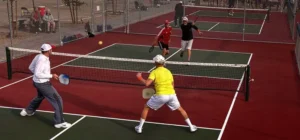
Playing pickleball on a tennis court can present some unique challenges and opportunities. Here are a few strategies to help you adapt your game and take advantage of the larger playing area:
- Utilize the extra space: With more room to work with, you can hit deeper, more angled shots to push your opponents back and create openings for yourself at the net. Use the extra space to your advantage by varying your shot placement and keeping your opponents on their toes.
- Adapt to the higher bounce: Tennis courts, particularly hard courts, may produce a higher bounce than a dedicated pickleball court. Adjust your swing and aim higher over the net to compensate for the increased bounce. This may require a bit of practice to find the right timing and trajectory.
- Exploit the tennis court features: Some tennis courts have features that can be used to your advantage in pickleball. For example, if there’s a back wall or fence, you can use it strategically for lob shots or to keep the ball in play. Just be sure to communicate with your opponents beforehand to establish any necessary rules or boundaries.
- Play smart in the wind: Outdoor tennis courts are more susceptible to wind than indoor pickleball courts. If you’re playing on a windy day, adjust your shot selection and aim accordingly. Lob shots and high, deep shots may be more effective in the wind than low, fast shots.
- Focus on your footwork: The larger court size means you’ll need to cover more ground during rallies. Focus on your footwork and court positioning to ensure you’re always ready for the next shot. Use quick, small steps to navigate the court efficiently and maintain your balance.
Safety Considerations
As with any sport, it’s essential to prioritize safety when playing pickleball on a tennis court. Here are a few key safety considerations to keep in mind:
- Ensure proper court setup: Before starting play, make sure the court is set up correctly and free of any hazards. Check for cracks, holes, or debris that could cause trips or falls. If using a portable net, ensure it is securely anchored and stable.
- Be aware of your surroundings: When playing on a multi-purpose court, be mindful of other activities happening around you. Look out for stray balls, players from adjacent courts, or spectators who may inadvertently interfere with your game.
- Wear appropriate footwear: Choose shoes with good lateral support, cushioning, and non-marking soles to prevent slips, falls, and injuries. Avoid running shoes with deep treads, as they can catch on the court surface and cause stumbles or twisted ankles.
- Warm-up and stretch: Before diving into a game, take a few minutes to warm up your muscles and joints. Perform light cardio exercises and dynamic stretches to increase your heart rate and loosen up your body. This will help prevent muscle strains and other injuries.
- Stay hydrated: Pickleball can be an intense workout, especially when played on a larger tennis court. Make sure to drink plenty of water before, during, and after your games to avoid dehydration and heat exhaustion.
- Use proper technique: When learning how to play pickleball on a tennis court, focus on using proper form and technique for shots, volleys, and serves. This will not only improve your game but also reduce the risk of overuse injuries like tennis elbow or shoulder strains.
- Communicate with other players: If you’re sharing the court with other pickleball or tennis players, communicate clearly to avoid collisions or confusion. Call out “ball!” if a stray ball enters your court, and be respectful of other players’ space and time on the court.
By keeping these safety considerations in mind, you can ensure a fun and injury-free experience when playing pickleball on a tennis court.
Organizing Pickleball Games on a Tennis Court
Now that you know how to set up and play pickleball on a tennis court, why not take it a step further and organize games or events for your community? Here are a few ideas:
- Schedule regular court time: Contact your local tennis facility or parks department to see if you can reserve court time for pickleball on a regular basis. Many facilities are happy to accommodate pickleball players during off-peak hours or on underutilized courts.
- Start a pickleball league or club: Gather a group of interested players and start a pickleball league or club. You can organize weekly games, tournaments, or social events to bring players together and promote the sport in your area.
- Host a pickleball clinic or workshop: If you’re an experienced pickleball player, consider hosting a clinic or workshop to teach others how to play pickleball on a tennis court. You can cover basic rules, techniques, and strategies, and provide hands-on instruction and practice time.
- Invite tennis players to try pickleball: Reach out to local tennis clubs, teams, or players and invite them to try pickleball. Many tennis players find that pickleball is a fun and engaging way to cross-train or enjoy a new challenge. You can organize a pickleball demo day or offer free introductory lessons to spark interest.
- Partner with local organizations: Look for opportunities to partner with local organizations, such as schools, community centers, or senior living facilities, to promote pickleball and host events. You can offer to teach classes, run tournaments, or provide equipment in exchange for court access or publicity.
By organizing pickleball games and events on tennis courts, you can help grow the sport in your community and create new opportunities for people to stay active, socialize, and have fun.
Conclusion
Learning how to play pickleball on a tennis court is a fantastic way to enjoy this fast-growing sport, even if you don’t have access to a dedicated pickleball facility. By following the tips and guidelines outlined in this article, you can easily transform a tennis court into a pickleball oasis and start playing with friends, family, or fellow enthusiasts. Find the Best Places to Play Pickleball! Click Here to Start Now!
Remember to:
- Adjust the net height and court dimensions to create a regulation pickleball court
- Use temporary line markings to define the court boundaries
- Adapt your playing style and strategies to the tennis court surface and size
- Prioritize safety by ensuring proper court setup, wearing appropriate gear, and communicating with other players
- Organize games, events, or clinics to promote pickleball and bring players together
With a little creativity and effort, you can turn any tennis court into a pickleball destination and help spread the joy of this addictive and social sport. So grab your paddles, round up some players, and get ready to have a blast playing pickleball on a tennis court!
FAQs
- Can you play pickleball on any tennis court?
- Yes, you can play pickleball on most tennis courts, as long as you have permission from the court owner or manager and follow any specific rules or guidelines they may have.
- How long does it take to set up a pickleball court on a tennis court?
- Setting up a pickleball court on a tennis court can take anywhere from 10-30 minutes, depending on the equipment you’re using and the number of courts you’re creating. With practice, you can streamline the process and get playing faster.
- What is the best surface for playing pickleball?
- While pickleball can be played on various surfaces, including clay, grass, and hard courts, the most common and preferred surface is a hard court with a smooth, even finish. This provides good ball bounce, traction, and durability for pickleball play.
- Can tennis and pickleball be played simultaneously on the same court?
- It’s generally not recommended to play tennis and pickleball simultaneously on the same court, as the different court sizes, net heights, and ball types can interfere with each other and create safety hazards. It’s best to designate specific times or areas for each sport to avoid confusion and collisions.
- Where can I find pickleball equipment for playing on a tennis court?
- Pickleball equipment, including paddles, balls, and portable nets, can be found at most sporting goods stores, online retailers, or specialty pickleball shops. Look for equipment that is USAPA approved and suitable for your skill level and playing style.
- Will playing pickleball damage tennis court surfaces?
- Playing pickleball on a tennis court should not cause significant damage, as long as players use appropriate footwear and equipment. Pickleball is a low-impact sport with lighter balls and less aggressive play than tennis. However, it’s always a good idea to check with the court owner or manager to ensure pickleball is allowed and to follow any maintenance or care guidelines they provide.
- How can I find other pickleball players to play with on a tennis court?
- There are many ways to connect with other pickleball players in your area, including:
- Joining local pickleball clubs, leagues, or Facebook groups
- Attending pickleball events, clinics, or tournaments
- Posting on community bulletin boards or online forums
- Inviting friends, family, or colleagues to learn and play with you
By reaching out and building a network of pickleball enthusiasts, you’ll always have someone to share a court with and enjoy the game together.
- There are many ways to connect with other pickleball players in your area, including:

